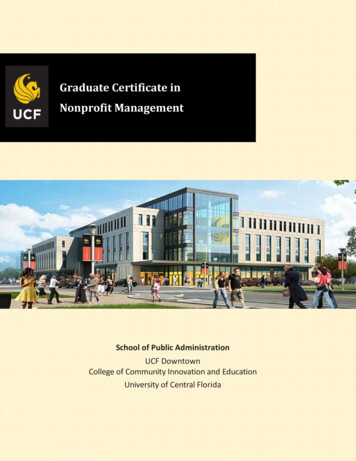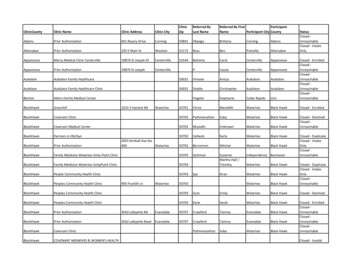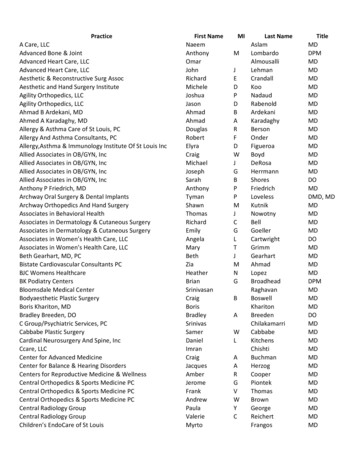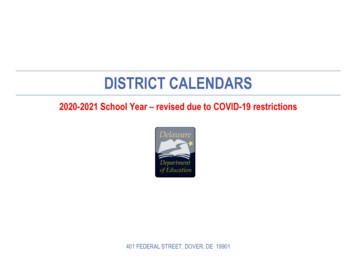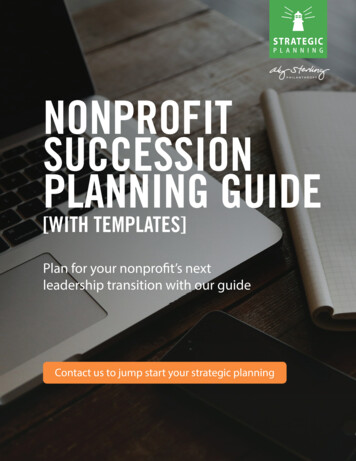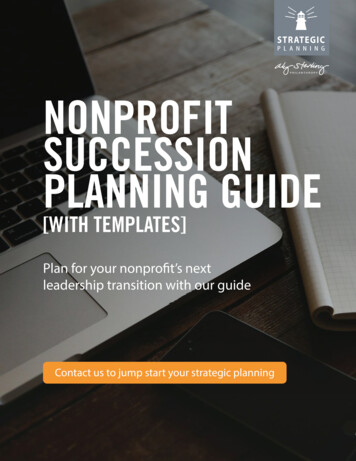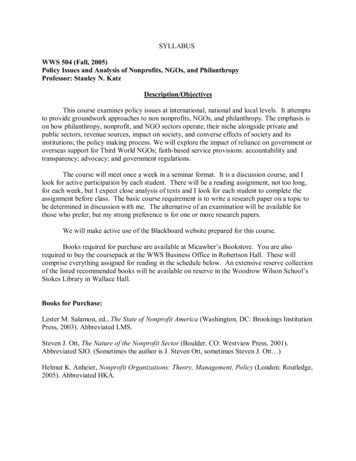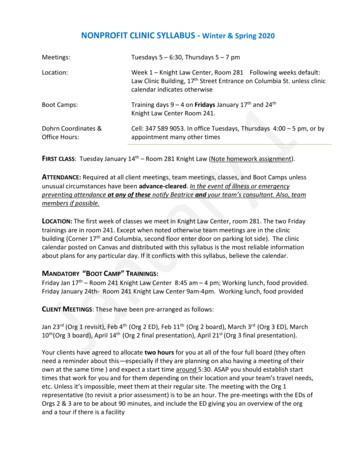
Transcription
NONPROFIT CLINIC SYLLABUS - Winter & Spring 2020Meetings:Tuesdays 5 – 6:30, Thursdays 5 – 7 pmLocation:Week 1 – Knight Law Center, Room 281 Following weeks default:Law Clinic Building, 17th Street Entrance on Columbia St. unless cliniccalendar indicates otherwiseBoot Camps:Training days 9 – 4 on Fridays January 17th and 24thKnight Law Center Room 241.Dohrn Coordinates &Office Hours:Cell: 347 589 9053. In office Tuesdays, Thursdays 4:00 – 5 pm, or byappointment many other timesFIRST CLASS: Tuesday January 14th – Room 281 Knight Law (Note homework assignment).ATTENDANCE: Required at all client meetings, team meetings, classes, and Boot Camps unlessunusual circumstances have been advance-cleared. In the event of illness or emergencypreventing attendance at any of these notify Beatrice and your team’s consultant. Also, teammembers if possible.LOCATION: The first week of classes we meet in Knight Law Center, room 281. The two Fridaytrainings are in room 241. Except when noted otherwise team meetings are in the clinicbuilding (Corner 17th and Columbia, second floor enter door on parking lot side). The cliniccalendar posted on Canvas and distributed with this syllabus is the most reliable informationabout plans for any particular day. If it conflicts with this syllabus, believe the calendar.MANDATORY “BOOT CAMP” TRAININGS:Friday Jan 17th – Room 241 Knight Law Center 8:45 am – 4 pm; Working lunch, food provided.Friday January 24th- Room 241 Knight Law Center 9am-4pm. Working lunch, food providedCLIENT MEETINGS: These have been pre-arranged as follows:Jan 23rd (Org 1 revisit), Feb 4th (Org 2 ED), Feb 11th (Org 2 board), March 3rd (Org 3 ED), March10th(Org 3 board), April 14th (Org 2 final presentation), April 21st (Org 3 final presentation).Your clients have agreed to allocate two hours for you at all of the four full board (they oftenneed a reminder about this—especially if they are planning on also having a meeting of theirown at the same time ) and expect a start time around 5:30. ASAP you should establish starttimes that work for you and for them depending on their location and your team’s travel needs,etc. Unless it’s impossible, meet them at their regular site. The meeting with the Org 1representative (to revisit a prior assessment) is to be an hour. The pre-meetings with the EDs ofOrgs 2 & 3 are to be about 90 minutes, and include the ED giving you an overview of the organd a tour if there is a facility
NONPROFIT CLINIC SYLLABUS - Winter & Spring 2020It is also required that members of your team sit in on at least one of the board meetings of Org2 & 3. You will be attending as observers, gathering data to help your team in preparing itsassessment. Most helpful will be to do this in advance of your interview, but if timing does notallow just make sure it comes in time to inform your assessment and report. The clients havelisted scheduled board meeting in their application, and I have endeavored to reconfirm thesemeetings early in the year, but you must confirm as they might have changed. It is notnecessary that all team members attend both orgs’ meetings. It probably makes sense to dividethis task up, if possible two attendees per meeting to report back to the team.REQUIRED SYSTEMS:The clinic uses the Canvas site for fie sharing and communication. There will not be an emaillist-serve, so it is important that you arrange your settings to receive announcements to youremail without delay as sometimes these are urgent.As whenever you act as a professional consultant, you are required to keep track of your timeon these projects. You will find a timesheet template on Canvas. Time sheets are due the firstFriday of the month following (Feb 7, March 7, April 4, and April 23).2
ABOUT WORKING IN THE NONPROFIT CLINICWelcome to the 2020 Nonprofit Clinic. You are one of the group of students that will beassisting twelve Oregon nonprofits. You will work on a team, accompanied by a consultant whois there to support your work. Each team will work with three clients. Your first project is toevaluate how one of last year’s assessments worked out for the client organization. It is acheck-in both on how they did and how we did. The next two organizations get a complete firsttime governance assessment that you will construct.The guiding expectation for your work in the clinic is that you will behave and performprofessionally and do what, in your professional judgment, is needed to provide your clientswith a thorough governance assessment, meaningful recommendations and a useful reportwith supporting resources.This experience will be very much like employment (which is quite different from taking acourse): when and how you work is dictated by what it will take for your team to create aquality product for the clients. You will reap rewards beyond academic credit from theexperience of interviewing and presenting your ideas to actual clients. The more useful theproduct, the greater those rewards! As in most of the working world, achieving quality willrequire working respectfully and in close cooperation with other professionals (yourteammates, consultant and me). You have an opportunity to practice professional judgment,dedication, skills and to get a lot more feedback than you are likely to receive once you are in ajob. Take advantage! Students who gain the most from this clinic treat it like a job.In a professional setting, you appear on behalf of your employer. Similarly, you will berepresenting the Nonprofit Clinic in your interactions with our clients. The clinic’s reputationdepends on each of you. As the clinic’s director, I am your metaphorical “boss,” and I care agreat deal about serving our clients well. This too is very much like the working world.On the other hand, unlike a real-world boss, I am highly available to provide you feedback andassistance, and encourage you to take advantage through office visits and team meetings.In addition, for these projects you are provided with a structure for your team’s work in theform of the clinic calendar. The required report submissions – outline, initial draft, next draft,close-to-final and final– will help you get your team’s assessment report to where it needs tobe in the timeframe we have. Each is a step along the path of your work, and your assessmentshould develop and grow more sophisticated as you sift through multiple drafts. Your workshould build from one draft to the next, with the help of feedback. At the end of this syllabusthere is a list of minimum expectations from these different phases. Please consult those beforeeach submission.3
CLINIC COURSE MATERIALSLEARNING OBJECTIVESThe overall aim of the Nonprofit Clinic is to give students an opportunity to experience workingas a consultant on a team of mixed disciplines to provide two nonprofit boards with highquality governance assessments.The aim for student development is to provide a chance to practice many skills relevant to yourfuture work: document review, interview prep, note taking, theme development, writing,presentation, meeting facilitation, among others, and doing all of the above on a team.You will interact with real-world clients and issues, practice many skills, and to get extensivefeedback and input both from a professional who will consult with your team, and from theclinic’s teacher/director.Apart from the skills practice, a key takeaway of the clinic is about how groups of peopleaccomplish work, and how to do that better. We apply this to client boards of directors;however, it is applicable to your future careers in the practice of law, to working withbusinesses, to conflict resolution and to nonprofit management.Where particular class or boot camp sessions are focused on subject-matter material, thissyllabus lists the goals of those classes.The learning objective of all team meetings is to provide structured time for your team tocomplete its assessment work and develop the reports, while taking advantage of guidance,feedback and resources you need from your consultant and the clinic director who will join yourteam for part of most meetings.REQUIRED READINGThe assigned readings for the clinic are not academic. They will help you perform theassessments and you should read them in advance and consult them throughout.1. By January 17th: The Five Dysfunctions of a Team, Lencioni (“Dysfunctions”) pp 1 – 228.You need not purchase this book; copies are available to borrow and are to be shared,two copies per team.2. Nonprofit Lifecycles, Stage-Based Wisdom for Nonprofit Capacity, Susan Kenney Stevens,(2nd Edition). (“Lifecycles”) pp 1 – 109. This is the only book you must purchase. Thebookstore has it. The lifecycles approach is a resource to be consulted and4
incorporated throughout your work. I will be looking to find its wisdom applied in yourdrafts, especially as it relates to developing a “theme” for your assessments.3. Principles for Good Governance and Ethical Practice – A Guide for Charities andFoundations – 2015 Edition (“Principles”) (Available free with log-in onhttps://www.independentsector.org/principles free pdf and on Canvas in PDF). This isan excellent compilation of best practices in the areas we will cover.NOTE: There are two versions of the principles, both posted on Canvas. They differ onlyin that one is the reference edition and is annotated – many footnotes with sourcescited. Going to the sources can help you in your work, so even if you use the shorterunannotated version, I suggest looking at the sources when you begin working with aparticular passage.4. It is very important that you be conversant with the information in your clients’ files andsurveys, which can be voluminous and slow reading (with the need to take lots ofnotes). The sooner you dive into them the more you will be able to apply the content ofthe classes and trainings to your upcoming work.5. The four 2018 Assessments under review this year & other samples posted on Canvas.(Org 1 reports)6. All materials your Org 2 and Org 3 clients have submitted, (in the files on Canvas); theresponses to the qualtrics survey taken by the client boards (accessed through your ownQualtrics account), and anything else publicly available about the nonprofits.7. Assigned readings on Canvas for training classes and Boot Camp days.8. Assigned videos on OneDrive for the same.OTHER RESOURCESAs in employment, in many instances you will need to find resources to better understand yourclients’ needs, or to help them. Canvas includes a file of resources that past students havefound helpful. The fact that something is posted does not make it a good choice for yourparticular assessment! Use and develop your judgment. Share with me new resources youlocate for posting and keep an eye on what your colleagues have found.There are also a number of resources on Canvas intended to help you create and structure yourassessment and its report. There is a lot there. Please consult these aids as questions orroadblocks arise in your work.5
JOURNALSJournals are due to Beatrice no later than 9am on each Thursday, except when indicatedotherwise on the Clinic Calendar. They are usually required of each student, but sometimes theassignment is a single team submission, or sometimes a draft that is due the serves as theweek’s journal.Topics are on a freestanding “Journal Assignments” list posted on Canvas, and any change willbe announced there. The calendar includes the title, though not the detailed prompt for eachjournal. Be sure to consult the full prompt in Canvas files.Use the opportunity of journaling to get feedback you need. The assignments are structured tohelp you stay on track, and also to be helpful to me in understanding your project (since I willbe commenting on your drafts), your contribution to it (which helps with what your gradeshould be). The happiest students, and the best reports usually result from fruitful exchangesearly in your process. If at some point addressing the exact assignment is not helpful, let meknow that and share something that will advance your work. Note however that the listedassignments are a good guide to structuring your work in the time we have.When sending your journal please: Send by email to bdohrn with your journal attached as a Word document. Put your name (or team in the case of team products), the date and the journal number ontop. Extra kudos for including a title that might be illuminating, funny or punny. Note that journals will be returned, cc to your consultant, with comments or response toyour inquiry, generally within a day. If you do not receive a response, it’s good toremind/ask me about it in case it got lost. Submissions later than the due time arediscouraged and might not get a quick reply. If you need more time let me know in advance.As in employment, missing a deadline without acknowledgement is not good form.Tardiness in journal submissions will affect credit for them.6
GRADINGStudents have the option of receiving a grade for their work in the Nonprofit Clinic. To pass thecourse under Pass/No Pass a student must earn a B. Grades are based on the clinic director’sassessment of student performance, taking into account the following factors: Work Product –Thirty five percent (35%). Quality of the team’s final product. This will focuson the assessment’s product which is primarily the report but also the presentation you maketo the client. The assessments are expected to be tailored to your clients, insightful, thematic,professional looking, well written, and to provide concrete recommendations. There is also anexpectation that you will provide the client with references to resources to aid them inimplementing or understanding your recommendations. the quality and individual effortreflected in your work on all aspects of the assessment. Participation and Professionalism– Forty percent (40%). Presence in body and mind, atclasses, any team meetings and trainings. This includes all aspects of contributing to yourteam’s work, including: preparation for and performance during client meetings;responsiveness to director’s and consultant’s feedback (including close attention to feedbackat each stage); jumping in to fill needs that arise such as formatting report, proofreading,resolving issues with client etc.; as well as your written contribution to the report and to theresources to be provided.Attendance at all client meetings is critical. Besides the obvious -- communication and serviceto the clients -- professionalism includes respecting confidentiality, meeting or exceeding thedeadlines for journals and drafts; and upholding your commitments to fellow team members,consultants and the clinic director. Willingness to learn and improve is also taken into account.Submission of time sheets is required. Journals –Fifteen percent (15%) . These are required to be submitted on time unless otherarrangements have been made. Good quality journals reflect your work on the project andshould demonstrate application of your thought, reading and training to your work for ourclients. Journals are intended to expose me to your present thought and work on the projectincluding reflections about your client, the assessment’s recommendations, your team’sprocess, etc. Simple diary narratives (this week we did x,y, and z) minus analysis is not what iscontemplated. Communication - Ten percent (10%). Commitment to clear communication exhibited whileworking and corresponding with clients, consultants, clinic director, and student colleagues.This includes adhering to team agreements, keeping others apprised of progress on clientwork and of any other issues with schedule or substance as they arise and generally staying intune with Canvas, email, slack or any other method the team choses to use to keepcoordinated7
POLICIESU OF OAccessible Education for All Students: The University of Oregon works to ensure inclusivelearning environments for all students. We recognize that students bring a variety of learningstyles to the course, and that some learning styles may require adjustment to coursestructure. We are happy to talk with you about adjustments you require as a result of learningstyle or diagnosed disability. Please be in touch with me if there are barriers to yourparticipation. For more information, you are also encouraged to contact the AccessibleEducation Center (formerly Disability Services) in 164 Oregon Hall at 541-346-1155 oruoaec@uoregon.edu.Inclusion and Collegiality: Our community values inclusion. We are committed to equalopportunities for all faculty, staff, and students to develop individually, professionally, andacademically regardless of ethnicity, heritage, gender, sexual orientation, ability, socioeconomic standing, cultural beliefs or traditions. We are dedicated to an environment that isinclusive and fosters awareness, understanding, and respect for diversity. If you feel excludedor threatened, please contact Associate Dean of Students Jennifer Espinola atespinola@uoregon.edu or 541-346-1557. The University Bias Response Team is also a resourcethat can assist you. See http://bias.uoregon.edu or call 541-346-2037.ASPIRATION FOR CLINIC 2020We are embarking on 14 weeks working intensely together. Let’s experiment in this setting withcreating a fully open atmosphere, where our team is strengthened by our differences. It isnearly assured that each one of us will – I presume unintentionally – at some point offend.Speaking and hearing from each other at those times is key. I am sure we will be enriched if wedo so sincerely, without drama, whenever something comes up in the course of our timetogether.8
WEEK-BY-WEEKWEEK OF JANUARY 6 No classes (Law classes yet to begin)Team assignments and client files are posted on Canvas. Take advantage of this time to dig in!There is an assignment due January 14th and quite a bit of reading required for January 17htraining so this is also a good place to get ahead.WEEK OF JANUARY 13JOURNAL #1 HOMEWORK FOR 1/14 CLASSWe will gather as a full class in Knight Law Center room 281 on both Tuesday and Thursday.TUESDAY 1/14 First class – Room 281 Introduction to each other and the ClinicREQUIRED READING Your org 1 assessment. This is one of last year’s assessments that your team will review. It isIMPORTANT that you come well familiar with this assessment having done the assignmentbelow. Note that Canvas has the assessment with all its appendices/resources. For thisclass focus on the report itself, only perusing resources attached.Lifecycles: Introduction pp 3-22 Principles (Using and Adapting the Principles) pp 7-8 Modules of our Assessment on Canvas and attached belowRECOMMENDED READING See reading required for Friday’s Training – suggest getting a start on itASSIGNMENT TO BRING TO CLASS – THIS IS ALSO JOURNAL 1 How, if at all, does your Org 1 assessment report employ the Lifecycle work?Did the team use some other tool to structure its work, in addition or instead? Explain.Did they do so to good effect? Explain.Beyond being a list of recommendations does the report offer a key takeaway that you caneasily identify? If so,o What is it?o Are the recs tied to it effectively?o If yes share some examples you liked,o If no, give some places you think it could have been done. In terms of the presentation of the ideas, share some suggestions that might have made thereport more useful to the client. List– bullet point style is fine— things you’ll aim to do in your own assessments, based onyour observations of this one.9
GOALSAt the end of this session, students will: Have been introduced to the Clinic’s participants and what they offer as resourcesHave been introduced to the process and have examined and discussed one of our priorassessmentsHave met with their teammates,shared about their Org 1 assessment, and begun toexchange ideas about their aspirations for their team’s workCLASS OUTLINE Brief Introductionso Consultantso Students- Program and year, prior NP experience what drew you to the clinic Walk through of the process/schedule for the assessments Intro to the clinic’s schedule/process Team time to discuss your homework, group discussion of your observations as anintroduction to the work you’ll do.THURSDAY 1/16Class – Room 281 Dohrn & GaryNonprofit Structure & Board’s RoleDuties of Directors and Legal Requirement of BoardsDiscussion of goals from Org 1 meeting and reportREQUIRED READING Principles Section 1 -- Legal Compliance and Public DisclosureJournal assignment # 3 (2? Where is 2?) to guide your preparation for Org 1 work.One of the other (apart from your own) Org 1 Assessments posted on CanvasFor Friday’s training:Lifecycles: pp 21 - 109Principles Section 2 -- Effective GovernanceProf Girvan’s posted MaterialsRECOMMENDED READING It would be wise to begin to read and take notes on Org 2 materials as you will needfamiliarity with them next week and they generally are voluminous and reading them istime consuming. TAKE NOTES. Even experienced assessors cannot remember all thedetails of organizations from document review without note-taking.10
GOALSAt the end of this session, students will: Understand the structural position of the Board of Directors in a NonprofitHave been introduced to the duties and obligations of nonprofit directors and the basiclegal and filing requirements for 501(c)(3)sCLASS OUTLINE Presentation on basic nonprofit structure and why board governance is the “hook” for ourassessments Discuss what comprises an “organization” Presentation on directors’ legal duties and filing requirements for 501(c)(3)s Opportunity to ask questions about Goals from Org 1 workFRIDAY 1/17Boot Camp – 8.45 am to 4 pm room 241 Knight Law See reading required above Governance (D. Mason)Students will learn about boards’ leadership in setting policy; organizational respect andunderstanding of board-staff roles and responsibilities, including review and supervisionof executive staff to aid them in conducting their assessments. The Lifecycle Approach (B. Dohrn)Students will learn about the Lifecycle model and discuss how it can guide theirassessments. We will also discuss the use of themes and overarching analysis generallyin our work. Interviewing a board (B. Dohrn)Orientation to the particular type of information required to conduct the clinic’sgovernance assessment, discussion of how best to elicit it from a group. J Conflict engagement for boards (J. Hudson)What we can offer to help boards benefit from, rather than suppressing diverseopinions, points of view, backgrounds and approaches. Diversity and Inclusion for boards (E. Girvan)A presentation from Professor Girvan about diversity and inclusion aims to illustrateconcrete ways that boards benefit from directors with diverse perspectives andexperiences. !11
WEEK OF JANUARY 20TUESDAY 1/21JOURNAL # 2Team meeting * – Clinic Building* Agendas for team meetings are generally the teams’ own responsibility. This list is offered toget you started at your first meeting and to bring your attention to some tasks that should beaddressed at your first and second meeting. Discuss and memorialize team agreements you would like to make. Presumably there hasbeen time on 1/17 to share about each of your personal workstyles.Prepare the Org 1 meeting Establish a contact person for each clientThis team member should email or call introducing self, team, and remind the clients of thedate, duration, location (and if electronic, method) of each client meeting. Also, the start timemust be finalized. There is one (1 hour) meeting with the Org 1 representative and then threemeetings with the other two Orgs. A total of seven meetings – all to be confirmed now.Below is what the clients have agreed to (you can also find this in their letter of acceptance, inyour client file. Notice that (in general – there are exceptions) the only matter left up in the airis whether the start time will be at 5:30 or earlier or later depending on your team’s needs,travel, etcPlease be clear that the purpose of confirmation is to make sure that they have this on theirradar, and to catch any miscommunications – it can happen! There is NOT flexibility at thispoint to change the dates of the meetings, or to make other major shifts. Past experience hasbeen that such changes at this point nearly always result in low turnout.Org 2 datesFeb 4th for ED meeting (ED meets with team, gives tour of facilities, an overview ofprograms , and answers questions. Allocate 90 minutes. Video conference ok)Feb 11th for full board meeting – 2 hours – this is info gathering/interviewApril 14th for presentation of assessment, workshop – allocate 2 hours.Org 3 datesMarch 3rd for ED meeting (ED meets with team, gives tour of facilities, an overview ofprograms , and answers questions. Allocate 90 minutes. Video conference ok)March 10th for full board meeting – 2 hours – this is info gathering/interviewApril 21st for presentation of assessment, workshop – allocate 2 hours.12
THURSDAY 1/23Meeting with Rep. from Org 1 5 pmFRIDAY 1/24Boot Camp – Knight Law Center, Room 241, 9 am to 4 pm (Skills day)Skills day! This will be a practice day focused on interacting with your clients. Hands-onexercises about conducting interviews & gathering information from your boards.WEEK OF JANUARY 27Journal #3 (Friday 9am- Org 1 Report)FULL TEAM TO SIGN UP FOR MEETING TO REVIEW YOUR WORK ON ARTICLES AND BYLAWS WITH BEATRICE IN TIMESLOTS SET ON FEB 4 & 5.TUESDAY 1/28Team meeting – Clinic BuildingTHURSDAY 1/30Class – Room 281Financial oversightThe Role of policiesConflicts of InterestHow to Review Articles and BylawsREQUIRED READING/LISTENING/PREP Principles pp 31 – 36 (Strong Financial Oversight)All Org 2 materialsProf. Irvin’s posted videosReading on Nonprofit Conflicts of Interest on CanvasConflicts of Interest – Video AssignmentGOALSAt the end of this session, students will: Have considered what to look at in evaluating their clients’ oversight of financesBe introduced to the role that policy promulgation plays in governanceBe introduced to what “conflict of interest” means in the context of 501(c)(3)Have had the opportunity to clarify what’s expected in the review of articles and bylaws13
CLASS OUTLINE Julie Weismann (clinic consultant) will present on considerations in assessing your clients’practices as to financial oversight/control.Beatrice will lead a discussion to be clear about the role of policy in board governance Questions about the conflict of interest video will be entertained. We will discuss how to review the clients’ Articles and Bylaws.HOMEWORKThe preparation of the Articles and Bylaws review for next week will require some time. Youmust review the video instructions and complete the project in advance of the (separatelyscheduled) meetings during the week of Feb 3. Put that project on your radar now.WEEK OF FEBRUARY 3Journal # 4TUESDAY 2/3Meeting with Org 2 ED 5:30 pmTEAM MEETINGS WITH BEATRICE FEB 3 & 5ARTICLES AND BYLAWS MEETING OUTLINEThis is a working session. Each team will have time to sit with Beatrice and go through theirmark-up of the Articles and Bylaws of orgs 2 & 3 page by pageREQUIRED PREPARATION Follow the video instructions posted on OneDriveCome to the session with a copy of your Org 2 & 3 Articles and Bylaws annotated with allcomments/changes you propose to presentGOALSAt the end of this session, students will have gone through their notes and questions on Org 2 &3’s Articles and Bylaws and be ready to finalize the suggestions they will make to their clients.Students must prepare these in advance, in writing.THURSDAY 2/5Team meeting – Clinic BuildingWEEK OF FEBRUARY 10 Journal # 5TUESDAY 2/11Interview with Org 2 5:30 pmTHURSDAY 2/13Team meeting – Clinic BuildingFRIDAY 2/145pm Outline Org 2 See syllabus appendix for guidelines14
WEEK OF FEBRUARY 17Journal #6 draft due fridayTUESDAY 2/17Team meeting – Clinic BuildingTHURSDAY 2/19Team meeting – Clinic BuildingFRDAY 2/205pmWEEK OF FEBRUARY 24Initial Draft Org 2 ( Journal 6)See syllabus appendix for guidelinesJournal # 7 (Tuesday 9am deadline)There will be office hours next week on March 2nd -4 th– mandatory – to discuss your work onthe draft. Sign up for a slot when Beatrice opens an electronic sign-up sheet.TUESDAY 2/25Team Meeting – Clinic BuildingTHURSDAY 2/27Team Meeting – Clinic BuildingFRIDAY 2/275 pm – Next draft of Org 2 due See syllabus appendix for guidelinesWEEK OF MARCH 1Journal # 8TUESDAY 3/3Meeting with Org 3 ED 5:30 pmMonday 3/2Tuesday 3/3Wednesday 3/4Individual meetings to discuss your work on the draftTHURSDAY 3/5Team Meeting – Clinic BuildingWEEK OF MARCH 9Journal # 9TUESDAY 3/10Interview with Org 3 5:30 pmTHURSDAY 3/12Team Meeting – Clinic BuildingSATURDAY 3/1410 am -Near Final of Org 2 (if not previously submitted). See syllabusappendix for guidelines15
WEEK OF MARCH 16No JournalExam prep week for PPPM and CRES. No conflict with exam timesTUESDAY 3/17Team Meeting – Clinic Building1 pm – Outline of Org 3 due See syllabus appendix for guidelinesTHURSDAY 3/19Team Meeting – Clinic BuildingFRIDAY 3/20 9AMFinal of Org 2unless other arrangements have been madeWEEK OF MARCH 23 SPRING BREAKWEEK OF MARCH 30JOURNAL 10 INITIAL DRAFT OF ORG 3 DUE 5PM FRIDAYThere will be office hours on April 7th and 8th – mandatory – to discuss your work on the draft.Sign up for a slot when Beatrice opens an electronic sign up sheet for you.TUESDAY 3/31Team Meeting – Clinic BuildingTHURSDAY 4/2Team Meeting – Clinic BuildingFRIDAY 4/35 pm – Initial Draft of Org 3 due See syllabus appendix for guidelinesJournal # 11 (5pm Friday)WEEK OF APRIL 6MONDAY 4/6: FINAL DEADLINE FOR ORG 2 E-DELIVERYTUESDAY 4/7FULL CLASS ROOM 281-- Workshop on presenting your assessmentsTUESDAY AND WEDNESDAY 4/7 & 8your work on the draftTHURSDAY 4/9Individual meetings with Beatrice (office hours) to discussTeam Meeting – Clinic Building10 am - Next Draft of Org 3 due See syllabus appendix guidelinesWEEK OF
1. By January 17th: The Five Dysfunctions of a Team, Lencioni ("Dysfunctions") pp 1 - 228. You need not purchase this book; copies are available to borrow and are to be shared, two copies per team. 2. Nonprofit Lifecycles, Stage-Based Wisdom for Nonprofit Capacity, Susan Kenney Stevens, (2nd Edition). ("Lifecycles") pp 1 - 109.


